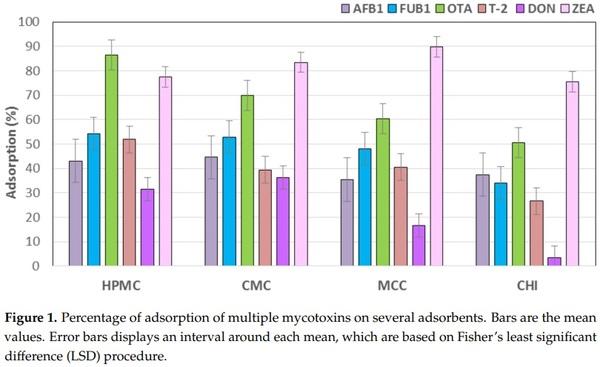Evaluation of Chitosan and Cellulosic Polymers as Binding Adsorbent Materials to Prevent Aflatoxin B1, Fumonisin B1, Ochratoxin, Trichothecene, Deoxynivalenol, and Zearalenone Mycotoxicoses Through an In Vitro Gastrointestinal Model for Poultry
1 Unidad de Investigación Multidisciplinaria. Facultad de Estudios Superiores Cuautitlán, Universidad Nacional Autónoma de Mexico, Cuautitlán Izcalli, Estado de Mexico 54714, Mexico; 2 Clermont-Université, Université d’Auvergne, EA4678, Conception Ingénierie et Développement de L’aliment et du Médicament, 63001 Clermont-Ferrand, France; 3 Department of Poultry Science, University of Arkansas, Fayetteville, AR 72701, USA; 4 Departamento de Medicina y Zootecnia de Aves, Facultad de Medicina Veterinaria y Zootecnia, Universidad Nacional Autónoma de México, Ciudad de Mexico 04510, Mexico.


1. Hussein, H.S.; Brasel, J.M. Toxicity, metabolism, and impact of mycotoxins on humans and animals. Toxicology
2001, 167, 101–134. [CrossRef]
2. Zain, M.E. Impact of mycotoxins on humans and animals. J. Saudi Chem. Soc. 2011, 15, 129–144. [CrossRef]
3. Armando, M.R.; Pizzolitto, R.P.; Dogi, C.A.; Cristofolini, A.; Merkis, C.; Poloni, V.; Dalcero, A.M.;
Cavaglieri, L.R. Adsorption of ochratoxin A and zearalenone by potential probiotic Saccharomyces cerevisiae strains and its relation with cell wall thickness. J. Appl. Microbiol. 2012, 113, 256–264. [CrossRef] [PubMed]
4. Streit, E.; Schatzmayr, G.; Tassis, P.; Tzika, E.; Marin, D.; Taranu, I.; Tabuc, C.; Nicolau, A.; Aprodu, I.; Puel, O.; et al. Current situation of mycotoxin contamination and co-occurrence in animal feed—Focus on Europe.
Toxins 2012, 4, 788–809. [CrossRef] [PubMed]
5. Smith, L.E.; Stoltzfus, R.J.; Prendergast, A. Food chain mycotoxin exposure, gut health, and impaired growth:
A conceptual framework. Adv. Nutr. 2012, 3, 526–531. [CrossRef] [PubMed]
6. Greco, M.V.; Franchi, M.L.; Rico Golba, S.L.; Pardo, A.G.; Pose, G.N. Mycotoxins and mycotoxigenic fungi in poultry feed for food-producing animals. Sci. World J. 2014, 2014, 968215. [CrossRef] [PubMed]
7. Andrade, P.D.; da Silva, J.L.G.; Caldas, E.D. Simultaneous analysis of aflatoxins B1, B2, G1, G2, M1 and ochratoxin A in breast milk by high-performance liquid chromatography/fluorescence after liquid-liquid extraction with low temperature purification (LLE-LTP). J. Chromatogr. A. 2013, 1304, 61–68. [CrossRef]
[PubMed]
8. Galarza-Seeber, R.; Latorre, J.D.; Bielke, L.R.; Kuttappan, V.A.; Wolfenden, A.D.; Hernandez-Velasco, X.;
Merino-Guzman, R.; Vicente, J.L.; Donoghue, A.; Cross, D.; et al. Leaky gut and mycotoxins: Aflatoxin B1 does not increase gut permeability in broiler chickens. Front. Vet. Sci. 2016, 3, 10. [CrossRef] [PubMed]
9. Jouany, J.P. Methods for preventing, decontaminating and minimizing the toxicity of mycotoxins in feeds.
Anim. Feed Sci. Technol. 2007, 137, 342–362. [CrossRef]
10. Méndez-Albores, A.; Arambula-Villa, G.; Loarca-Piña, M.G.; Castano-Tostado, E.; Moreno-Martínez, E.
Safety and efficacy evaluation of aqueous citric acid to degrade B-aflatoxins in maize. Food Chem. Toxicol.
2005, 43, 233–238. [CrossRef] [PubMed]
11. Kolosova, A.; Stroka, J. Evaluation of the effect of mycotoxin binders in animal feed on the analytical performance of standardised methods for the determination of mycotoxins in feed. Food Addit. Contam. Part
A Chem. Anal. Control Expo. Risk Assess. 2012, 29, 1959–1971. [CrossRef] [PubMed]
12. Avantaggiato, G.; Solfrizzo, M.; Visconti, A. Recent advances on the use of adsorbent materials for detoxification of Fusarium mycotoxins. Food Addit. Contam. 2005, 22, 379–388. [CrossRef] [PubMed]
13. Piotrowska, M.; Masek, A. Saccharomyces cerevisiae cell wall components as tools for ochratoxin a decontamination. Toxins 2015, 7, 1151–1162. [CrossRef] [PubMed]
14. Di Natale, F.; Gallo, M.; Nigro, R. Adsorbents selection for aflatoxins removal in bovine milks. J. Food Eng.
2009, 95, 186–191. [CrossRef]
15. Hokkanen, S.; Bhatnagar, A.; Sillanpää, M. A review on modification methods to cellulose-based adsorbents to improve adsorption capacity. Water Res. 2016, 91, 156–173. [CrossRef] [PubMed]
16. Silva, F.C.; Lima, L.C.; Bezerra, R.D.; Osajima, J.A.; Silva Filho, E.C. Use of Cellulosic Materials as Dye
Adsorbents—A Prospective Study. In Cellulose-Fundamental Aspects and Current Trends; InTech: Rijeka, Croatia,
2015; Available online: https://www.intechopen.com/books/cellulose-fundamental-aspects-and-currenttrends/use-of-cellulosic-materials-as-dye-adsorbents-a-prospective-study (accessed on 27 June 2017).
17. Tan, K.B.; Abdullah, A.Z.; Horri, B.A.; Salamatinia, B. Adsorption mechanism of microcrystalline cellulose as green adsorbent for the removal of cationic methylene blue dye. J. Chem. Soc. Pak. 2016, 38, 651–664.
18. Zhao, Z.; Liu, N.; Yang, L.; Wang, J.; Song, S.; Nie, D.; Yang, X.; Hou, J.; Wu, A. Cross-linked chitosan polymers as generic adsorbents for simultaneous adsorption of multiple mycotoxins. Food Control 2015, 57,
362–369. [CrossRef]
19. Bornet, A.; Teissedre, P. Chitosan, chitin-glucan and chitin effects on minerals (iron, lead, cadmium) and organic (ochratoxin A) contaminants in wines. Eur. Food Res. Technol. 2008, 226, 681–689. [CrossRef]
20. Filipkowska, U.; Józwiak, T.; Szymczyk, P. Application of cross-linked chitosan for phosphate removal from aqueous solutions. Prog. Chem. Appl. Chitin Deriv. 2014, 19, 5–14.
21. Wysokowski, M.; Klapiszewski, Ł.; Moszynski, D.; Bartczak, P.; Szatkowski, T.; Majchrzak, I.;
Siwinska-Stefanska, K.; Bazhenov, V.V.; Jesionowski, T. Modification of Chitin with Kraft Lignin and
Development of New Biosorbents for Removal of Cadmium(II) and Nickel(II) Ions. Mar. Drugs 2014, 12,
2245–2268. [CrossRef] [PubMed]
22. Szymczyk, P.; Filipkowska, U.; Józwiak, T.; Kuczajowska-Zadrozna, M. Phosphate removal from aqueous solutions by chitin and chitosan in flakes. Prog. Chem. Appl. Chitin Deriv. 2016, 21, 192–202.
23. Ledoux, D.R.; Rottinghaus, G.E. In vitro and in vivo testing of adsorbents for detoxifying mycotoxins in contaminated feedstuffs. In Biotechnology in the Feed Industry; Nottingham University Press: Nottingham,
UK, 1999; pp. 369–379.
24. Avantaggiato, G.; Havenaar, R.; Visconti, A. Assessing the zearalenone-binding activity of adsorbent materials during passage through a dynamic in vitro gastrointestinal model. Food Chem. Toxicol. 2003, 41,
1283–1290. [CrossRef]
25. Avantaggiato, G.; Havenaar, R.; Visconti, A. Evaluation of the intestinal absorption of deoxynivalenol and nivalenol by an in vitro gastrointestinal model, and the binding efficacy of activated carbon and other adsorbent materials. Food Chem. Toxicol. 2004, 42, 817–824. [CrossRef] [PubMed]
26. Kong, C.; Shin, S.Y.; Kim, B.G. Evaluation of mycotoxin sequestering agents for aflatoxin and deoxynivalenol:
An in vitro approach. Springerplus 2014, 3, 346. [CrossRef] [PubMed]
27. National Research Council. Nutrient Requirements of Poultry, 9th ed.; National Academy Press: Washington,
DC, USA, 1994; pp. 26–34.
28. Cobb-Vantress Inc. Cobb 500 Broiler Performance and Nutrition Supplement. 2013. Available online: http://www.cobb-vantress.com/products/guide-library/cobbsasso/broiler-performance-and-nutritionsupplement (accessed on 12 June 2016).
29. Annett, C.; Viste, J.; Chirino-Trejo, M.; Classen, H.; Middleton, D.; Simko, E. Necrotic enteritis: Effect of barley, wheat and corn diets on proliferation of Clostridium perfringens type A. Avian Pathol. 2002, 31, 598–601.
[CrossRef] [PubMed]
30. Latorre, J.D.; Hernandez-Velasco, X.; Kuttappan, V.A.; Wolfenden, R.E.; Vicente, J.L.; Wolfenden, A.D.;
Bielke, L.R.; Prado-Rebolledo, O.F.; Morales, E.; Hargis, B.M.; et al. Selection of Bacillus spp. for cellulase and xylanase production as direct-fed microbials to reduce digesta viscosity and Clostridium perfringens proliferation using an in vitro digestive model in different poultry diets. Front. Vet. Sci. 2015, 2, 25. [CrossRef]
[PubMed]
31. Wang, R.; Fui, S.; Miao, C.; Feng, D. Effects of different mycotoxin adsorbents on performance, meat characteristics and blood profiles of avian broilers fed mold contaminated corn. Asian-Aust. J. Anim. Sci.
2006, 19, 72–79. [CrossRef]
32. Kana, J.R.; Gnonlonfin, B.G.; Harvey, J.; Wainaina, J.; Wanjuki, I.; Skilton, R.A.; Teguia, A. Assessment of aflatoxin contamination of maize, peanut meal and poultry feed mixtures from different agroecological zones in Cameroon. Toxins 2013, 5, 884–894. [CrossRef] [PubMed]
33. Kubena, L.F.; Harvey, R.B.; Huff, W.E.; Elissalde, M.H.; Yersin, A.G.; Phillips, T.D.; Rottinghaus, G. Efficacy of a hydrated sodium calcium aluminosilicate to reduce the toxicity of aflatoxin and diacetoxyscirpenol.
Poult. Sci. 1993, 72, 51–59. [CrossRef] [PubMed]
34. Watts, C.; Chen, Y.; Ledoux, D.; Broomhead, J.; Bermudez, A.; Rottinghaus, G. Effects of multiple mycotoxins and a hydrated sodium calcium aluminosilicate in poultry. Int. J. Poult. Sci. 2003, 2, 372–378.
35. Rawal, S.; Kim, J.E.; Coulombe, R. Aflatoxin B1 in poultry: Toxicology, metabolism and prevention. Res. Vet.
Sci. 2010, 89, 325–331. [CrossRef] [PubMed]
36. Khan, F.A.; Zahoor, M. In vivo detoxification of aflatoxinB1 by magnetic carbon nanostructures prepared from bagasse. BMC Vet. Res. 2014, 10, 255. [CrossRef] [PubMed]
37. Siró, I.; Plackett, D. Microfibrillated cellulose and new nanocomposite materials: A review. Cellulose 2010, 17,
459–494. [CrossRef]
38. LaCount, W.; An, G.; Lee, J.M. The effect of polyvinylpyrrolidone (PVP) on the heavy chain monoclonal antibody production from plant suspension cultures. Biotechnol. Lett. 1997, 19, 93–96. [CrossRef]
39. Yu, L.; Dean, K.; Li, L. Polymer blends and composites from renewable resources. Prog. Polym. Sci. 2006, 31,
576–602. [CrossRef]
40. Sawyer, C.B.; Reed, J.S. Adsorption of hydroxypropyl methyl cellulose in an aqueous system containing multicomponent oxide particles. J. Am. Ceram. Soc. 2001, 84, 1241–1249. [CrossRef]
41. Suteu, D.; Biliuta, G.; Rusu, L.; Coseri, S.; Nacu, G. Cellulose cellets as new type of adsorbent for the removal of dyes from aqueous media. EEMJ 2015, 14, 525–532.
42. Tritt-Goc, J.; Kowalczuk, J.; Pislewski, N. Hydration of hydroxypropylmethyl cellulose: Effects of pH and molecular mass. PACS A 2005, 108, 197–206. [CrossRef]
43. Wang, J.; Somasundaran, P. Adsorption and conformation of carboxymethyl cellulose at solid-liquid interfaces using spectroscopic, AFM and allied techniques. J. Colloid Interface Sci. 2005, 291, 75–83. [CrossRef]
[PubMed]
44. Pensini, E.; Yip, C.M.; O’Carroll, D.; Sleep, B.E. Carboxymethyl cellulose binding to mineral substrates:
Characterization by atomic force microscopy-based force spectroscopy and quartz-crystal microbalance with dissipation monitoring. J. Colloid Interface Sci. 2013, 402, 58–67. [CrossRef] [PubMed]
45. Kurtbay, H.M.; Bekçi, Z.; Merdivan, M.; Yurdakoç, K. Reduction of ochratoxin a levels in red wine by bentonite, modified bentonites, and chitosan. J. Agric. Food Chem. 2008, 56, 2541–2545. [CrossRef] [PubMed]












.jpg&w=3840&q=75)